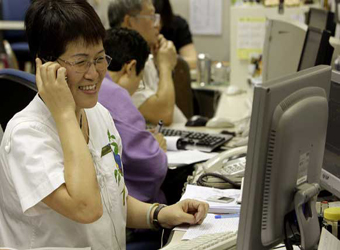Stocks in Asia rose on Monday, as markets shrugged off declines seen on Wall Street after a week largely dominated by U.S.-China trade developments.
The Nikkei 225 edged up by 0.69 percent after mostly directionless trade early in the session. The broader Topix also erased early losses and last traded higher by 0.4 percent, with declines in the oil and coal subindex offset by gains in financials and retailers.
South Korea’s Kospi advanced 0.48 percent. The technology sector mostly traded higher, but losses were seen in steelmakers and automakers. Samsung Electronics rose 1.36 percent and Posco was down 1.72 percent.
Greater China markets were also buoyant. Hong Kong’s Hang Seng Index rose 1.3 percent, outperforming its regional peers as technology and financials stocks put in strong showings. On the mainland, the Shanghai composite and Shenzhen composite both edged up by 0.25 percent.
Meanwhile, Australia’s S&P/ASX 200 was added 0.31 percent as most sectors traded in the green.
The gains in Asia came after U.S. stocks fell on Friday amid trade concerns. The Dow Jones industrial average closed in correction territory, falling 2.34 percent, or 572.46 points, to close at 23,932.76.
U.S. stock index futures climbed during Asia afternoon trade, with Dow futures last higher by 145 points.
Markets have focused on the escalation in trade-related rhetoric between the U.S. and China in recent weeks, although fears appeared to have eased slightly during Asian trade. U.S. stocks came under pressure after President Donald Trump on Thursday said he had instructed U.S. trade officials to consider $100 billion in additional tariffs on Chinese goods.
In response, China’s Ministry of Commerce said on Friday that it would “immediately fight back with a major response” if the U.S. went ahead with its plan to impose tariffs on $100 billion in Chinese imports.
Trump said in a tweet on Sunday that China would remove its trade barriers as that would be the “right thing to do.” Markets also awaited Chinese President Xi Jinping’s Tuesday speech at the Boao Forum.
Investors have been on edge over how heightened trade tensions between the world’s two largest economies could result in a potential trade war. That could, in turn, dent global economic growth and corporate profits.
Some analysts, however, saw the escalation as a part of Trump’s negotiating tactics and are hopeful about talks between the two countries.
“[W]e are starting to see a lessening in the severity of the moves, especially in the foreign exchange market where the market is looking for confirmation of action before committing to a trend,” Rakuten Securities Australia said in a note.
Against the yen, the dollar firmed slightly to trade at 107.01 by 1:25 p.m. HK/SIN. The dollar index, which tracks the dollar against a basket of currencies, stood at 90.162.
On the commodities front, oil prices edged higher after settling more than 2 percent lower in the last session. U.S. West Texas Intermediate futures added 0.45 percent to trade at $62.34 per barrel. Brent crude futures advanced by 0.46 percent to trade at $67.42.
In individual movers, shares of aluminum producer Rusal fell 39.66 percent. The Hong Kong-listed company, which is headquartered in Russia, was included in a U.S. sanctions list, according to Reuters.
Besides trade concerns, markets also digested the release of March nonfarm payrolls on Friday. Nonfarm payrolls rose 103,000 last month, missing an expected gain of 193,000.
Also of note, Federal Reserve Chairman Jerome Powell said Friday that gradual interest rate increases were needed, although he did not say exactly how many rate hikes were necessary.
Source: CNBC
